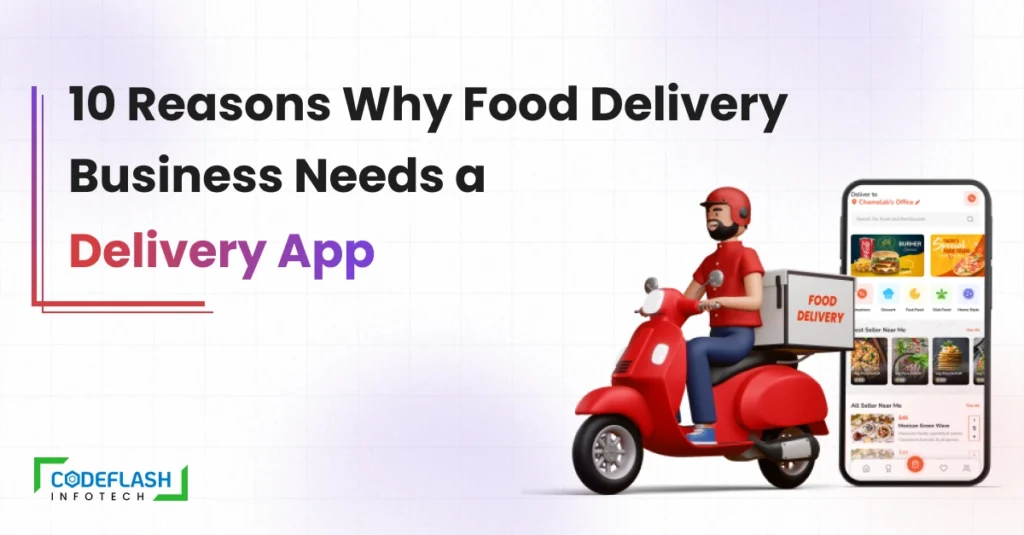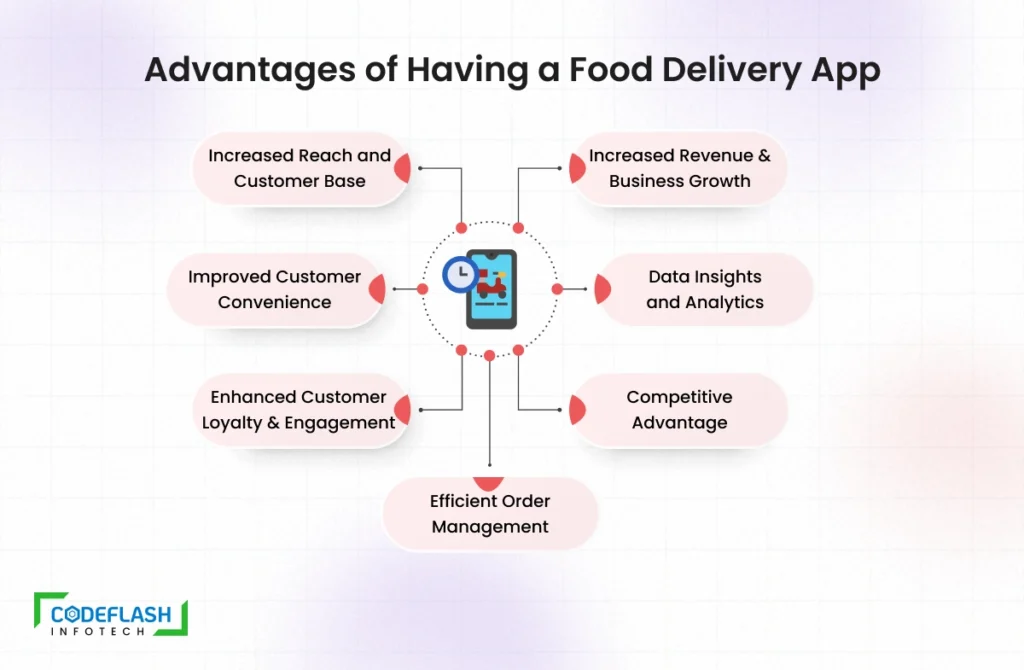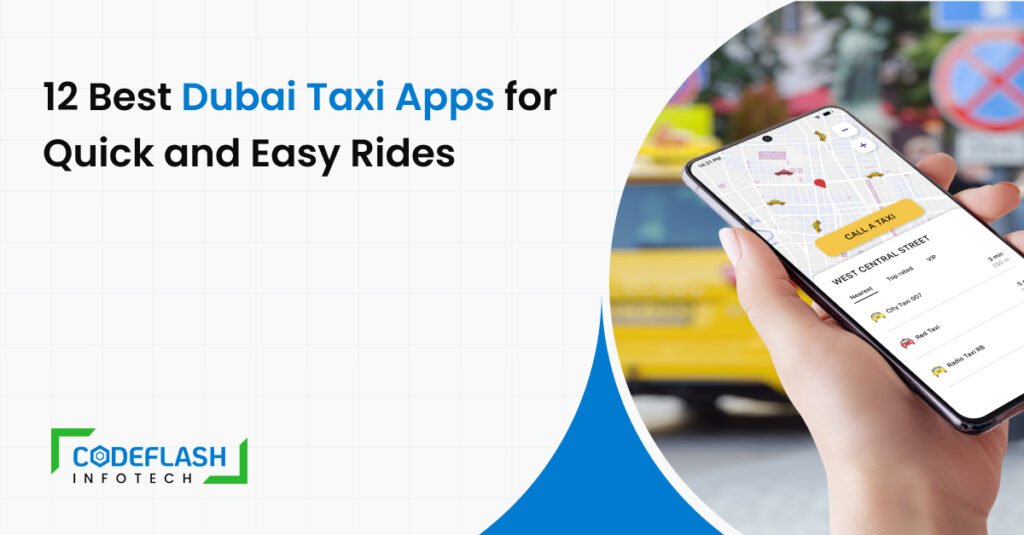
10 Reasons Why Food Delivery Business Needs a Delivery App in 2023
18 AUGUST
Are you a food delivery business company that delivers meals often seeking for methods to enhance and optimize your processes?
In today’s digital age, having a food delivery app has become essential for any successful food delivery business. Why Food Delivery Business Needs a delivery App the ease of having an intuitive app cannot be emphasized, with more people than ever buying meals online. In this blog post, we’ll explore 10 reasons Why Food Delivery Businesses Need Mobile Apps in 2024. From improved customer experience to increased efficiency, read on to learn how a mobile app can take your business to the next level!
What are the Objectives of Developing a Food Delivery app?
For clients to have a better user experience and to receive food more quickly, a food delivery service needs a custom food delivery app development solution. Customers can monitor their orders, get delivery status updates, and pay for their products all in one spot thanks to on-demand food delivery apps. that’s a why on-demand food Delivery businesses choose the best food delivery business models where customers can get benefits of rewards points and many more.

Reasons Why Food Delivery Business Needs a Delivery Apps in 2023
People are depending on technology more and more as the globe develops.
Over 60% of people worldwide are predicted to own smartphones by 2024.
SEE ALSO : Top Food Delivery Apps in USA
For businesses, this is a big market that is only expanding. With this in mind, it’s no surprise that many businesses are wanting to develop AI-based mobile apps to reach their customers and provide the latest technology to speed up the process.
- Customers have more convenience by using food delivery apps that allow them to easily explore menus, make orders, and monitor the status of their deliveries inreal-timee. To place an order, they are no longer needed to call someone or wait on hold. Customers may use the app to quickly and easily order their favorite dishes from restaurants using only a few clicks on their cellphones. This increased convenience leads to higher customer satisfaction and loyalty.
Expanding Customer Base:
A food delivery app enables food delivery businesses to reach a wider customer base. Many consumers prefer the ease of online meal ordering and home delivery in today’s fast-paced environment. By having a delivery app, businesses can tap into this growing market of tech-savvy customers who prefer the ease of using an app for their food deliveries. This helps businesses attract new customers and increase their order volumes.
Improved Operational Efficiency:
A food delivery app streamlines the entire ordering and delivery process, leading to improved operational efficiency. Orders placed through the app are automatically sent to the kitchen, reducing the chances of miscommunication or errors. Delivery routes can be optimized using GPS technology, ensuring drivers take the most efficient paths to deliver orders. This results in faster order processing, reduced delivery times, and, ultimately, happier customers.
Enhanced Customer Engagement:
A food delivery app provides food delivery businesses a direct channel to engage and interact with customers. Through push notifications, businesses can send personalized offers, discounts, and updates about new menu items or promotions. This direct communication helps businesses build customer loyalty, increase repeat orders, and create a sense of community. Customers may also immediately rate and comment on businesses’ products via the app, allowing them to learn important information and enhance their offerings.
Access to Valuable Data and Analytics:
A food delivery app generates valuable data and analytics that can be leveraged to make informed business decisions. Businesses can gather information about customer preferences, order patterns, peak hours, and popular menu items. This data can be used to tailor marketing campaigns, optimize menu offerings, and improve operational efficiency. With access to these insights, food delivery businesses can make data-driven decisions to stay competitive and meet customer expectations.
Stay Competitive in the Digital Era:
In 2023, the digital landscape continues to evolve rapidly, and customers increasingly rely on technology for their daily activities, including food ordering. By having a delivery app, your business can keep up with digital trends and provide customers with the convenience they expect. It helps you stay competitive and relevant in the market.
Personalized Customer Experience:
A food delivery app allows you to personalize the customer experience based on their preferences and previous orders. You can use data analytics to recommend relevant menu items, offer personalized promotions, and create a tailored experience for each customer. This personalization enhances customer satisfaction and increases the likelihood of repeat orders.
Efficient Order Management and Fulfillment:
A food delivery app streamlines the order management and fulfilment process. It automates various tasks such as order routing, the printing of receipts, and integration with your kitchen or POS system. This automation minimizes errors and reduces manual intervention, resulting in smoother operations and faster order fulfilment.
Cost Savings and Increased Profitability:
While developing a food delivery app requires an initial investment, it can lead to long-term cost savings and increased profitability. Reducing manual processes and optimizing operations can minimize labour costs and improve efficiency. Additionally, a delivery app enables you to reach a larger customer base, potentially increasing sales and revenue.
Access to Valuable Insights and Analytics:
A food delivery app provides access to valuable insights and analytics about customer behaviour, ordering patterns, and popular menu items. You may use this data to your advantage to optimise your menu, pricing plans, and marketing initiatives. The insights gained from the app can help you identify growth opportunities and improve your overall business performance.
How to Develop a Food Delivery App?
What features and functionality does your app have? Choose the essential attributes and capabilities for your food ordering or a meal delivery app. This may include menu browsing, ordering, payment processing, order tracking, delivery management, customer reviews, etc. Consider the needs of your customers and business operations when determining the features.
Conduct Market Research:
Conduct thorough market research and competitor analysis to gain insights into user preferences, prevailing industry trends, and promising avenues. Pinpoint the distinctive features and differentiating factors that will set your app apart, giving it a competitive edge. For further in-depth insights, refer to our blog titled “Comprehensive Guide to the Online Food Delivery Business Model.”Create Wireframes and Design:
Begin by crafting wireframes, which serve as foundational blueprints showcasing the app’s architecture and user flow. Once the wireframes are finalized, focus on refining the app’s visual aesthetics, aligning them with your brand essence, and providing an intuitive interface. Alternatively, you have the option to engage a professional UI/UX design firm for this purpose.Choose the Right Technology Stack:
Pick the Correct Technology Stack: Based on your app’s needs, such as the platform (iOS, Android, or both), backend infrastructure, and other factors, pick the correct technology stack.Develop the Backend:
Hire the Backend developer who will handle user authentication, order management, menu updates, payment processing, and integrating with third-party services (e.g., payment gateways and mapping services).Frontend Development:
Create the frontend components, screens, and interactions that users will interact with and experience. Prioritize an intuitive and visually captivating design that seamlessly adapts to various devices for a responsive user experience. To expedite this process, consider enlisting the expertise of a skilled Front-end developer.Integrate Third-Party Services:
Integrate essential services like payment gateways, location services (for address lookup and mapping), SMS or push notification services and any other APIs required for your app’s functionality.Implement Features and Functionality:
Develop the core features of your food delivery app, such as menu browsing, order placement, payment processing, and real-time order tracking. Implement additional features like customer reviews, loyalty programs, and social sharing per your initial requirements.Test and Debug:
Thoroughly test your app to identify and fix any bugs, errors, or usability issues. Incorporate user feedback to improve the app’s performance and user experience.Deploy and Launch:
Get your app ready for deployment on the Google Play Store and Apple App Store. Make sure to have all essential assets, descriptions, and screenshots prepared. Adhere to the guidelines set by each app store, and initiate the submission of your app for review and approval. To ensure a smooth process, consider using an App Store Submission Checklist as a guide.Monitor, Update, and Maintain:
Once your app is live, monitor its performance, collect user feedback, and address any reported issues promptly. Regularly update your app with bug fixes, feature enhancements, and security patches. Consider implementing analytics tools to gather insights and improve your app over time.

Benefits of Having a Food Delivery App
Increased Reach and Customer Base:
A food delivery app allows you to expand your reach and tap into a larger customer base. You may satisfy consumers who prefer the ease of placing food orders via their smartphones and having them delivered right to their door by creating an app. This opens up new growth opportunities and helps you attract customers who may not have visited your physical location.Improved Customer Convenience:
A food delivery app provides your customers a seamless and convenient ordering experience. They can easily browse your menu, customize their orders, and make payments online. Customers may place orders whenever it’s convenient for them via the app, eliminating the need to stand in queue or making phone calls. This convenience leads to higher customer satisfaction and encourages repeat orders.Enhanced Customer Loyalty and Engagement:
With a food delivery app, you can build stronger customer relationships and enhance customer loyalty. You can keep customers engaged and informed about promotions, discounts, and new menu items through push notifications and personalised offers. The app also allows you to gather customer feedback, improve your services and promptly address concerns.Efficient Order Management:
A food delivery app streamlines your order management process, making it more efficient and error-free. Orders placed through the app are directly transmitted to your kitchen or POS system, reducing the chances of miscommunication or mistakes. This improves order accuracy and minimizes manual data entry, saving time and reducing operational costs.Increased Revenue and Business Growth:
By developing a food delivery app, you can generate additional revenue streams for your business. With the growing demand for food delivery services, having an app position you to capture a larger share of the market. The app also enables you to upsell and cross-sell menu items, offer special promotions, and cater to a wider audience, ultimately leading to increased sales and business growth.Data Insights and Analytics:
A food delivery app provides valuable data and analytics that can help you make data-driven business decisions. You can gather insights about customer preferences, order patterns, peak hours, and more. This information allows you to tailor your menu, optimize delivery routes, and develop targeted marketing strategies. You may continually enhance your operations and beat the competition by using data analytics.Competitive Advantage:
In today’s competitive landscape, having a food delivery app gives you a competitive advantage. It demonstrates that your business is keeping up with the latest technology trends and meeting customer expectations. Customers are more inclined to patronise a company that provides a practical and user-friendly app than one that only accepts orders via conventional ways.
Conclusion
In order for businesses to remain competitive in the ever-expanding food delivery market, they must have a food delivery app. Businesses may offer their consumers a quick and easy method to order meals from anywhere by developing a mobile application. Whether you are starting a new food delivery business or already have one up and running, investing and developing a food delivery app now will provide your company a competitive edge for years to come.





